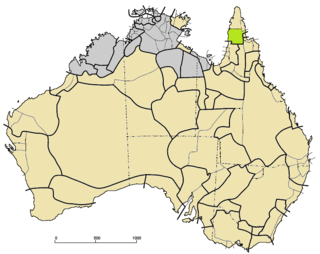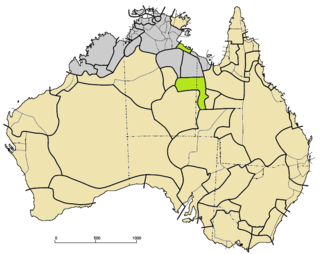
The Pama–Nyungan languages or Uthuru languages are the most widespread family of Australian Aboriginal languages, containing 306 out of 400 Aboriginal languages in Australia. The name "Pama–Nyungan" is a merism: it is derived from the two end-points of the range, the Pama languages of northeast Australia and the Nyungan languages of southwest Australia.
Kuku-Thaypan is an extinct Paman language spoken on the southwestern part of the Cape York Peninsula, Queensland in Australia, by the Kuku-Thaypan people. The language was sometimes called Alaya or Awu Alaya. Koko-Rarmul may have been a dialect, though Bowern (2012) lists Gugu-Rarmul and Kuku-Thaypan as separate languages. The last native speaker, Tommy George, died on 29 July 2016 in Cooktown Hospital.
Aghu Tharrnggala is an extinct Paman language of the Cape York Peninsula in Queensland, Australia. Like several languages in the area, it is often referred to as Gogo Mini (Kuku-Mini) 'good speech'. Some sources treat Ikarranggali, and Alngula (Alungul) as synonyms. However, they are distinct languages.

The North Cape York Paman languages are a subdivision of the Paman languages consisting of forty languages, all spoken on the Cape York Peninsula of Queensland, Australia. The languages are grouped largely according to R. M. W. Dixon. The only extant branches of this family are Umpila and the Wik languages. The now-extinct Northern Paman branch was unique among Pama-Nyungan languages in containing fricatives.

The Wik languages are a subdivision of the Paman languages consisting of sixteen languages, all spoken on the Cape York Peninsula of Queensland, Australia. This grouping was first proposed by R. M. W. Dixon.
Yir-Yoront was a Paman language spoken in two settlements, Kowanyama and Pormpuraaw on the southwestern part of the Cape York Peninsula, Queensland in Australia, by the Yir-Yoront people. In 1991 only 15 speakers remained, with the rest of the Yir-Yoront people speaking English or even Kuuk Thaayorre as many speakers of Yir-Yoront apparently are using Kuuk Thaayorre in daily conversation. At present it is thought to be extinct. There are two sister dialects, Yir-Yoront proper and Yirrk-Thangalkl, which are very close. The shared name Yir is sometimes used for both taken together.

The Paman languages are an Australian language family spoken on Cape York Peninsula, Queensland. First noted by Kenneth Hale, Paman is noteworthy for the profound phonological changes which have affected some of its descendants.

The Ngarna or Warluwar(r)ic languages are a discontinuous primary branch of the Pama–Nyungan language family of Australia. The moribund Yanyuwa language is the only survivor of this group.
Kuuk Thaayorre (Thayore) is a Paman language spoken in the settlement Pormpuraaw on the western part of the Cape York Peninsula, Queensland in Australia by the Thaayorre people. As of 2006, 250 of the 350 ethnic Thaayorre spoke the language. It is in a robust position compared to many indigenous Australian languages, as it is still being acquired by children and used in daily interaction.
Yirrk-Thangalkl is a dialect of Yir-Yoront, a Paman language spoken on the southwestern part of the Cape York Peninsula, Queensland in Australia, by the Yirrk-Thangalkl people. The language is also known as Yirr-Thangell and Yirrk-Mel.
The Yir-Yoront, also known as the Yir Yiront, are an Indigenous Australian people of the Cape York Peninsula now living mostly in Kowanyama but also in Lirrqar/Pormpuraaw, both towns outside their traditional lands.
The Thaayorre, or Kuuk Thaayore, are an Australian people living on the southwestern part of the Cape York Peninsula, Queensland in Australia, primarily in the settlement Pormpuraaw, having its foundation in the Edward River Mission.
The Uw Oykangand, otherwise known as the Kwantari, are an Aboriginal Australian people living on the southwestern part of the Cape York Peninsula, in the state of Queensland in Australia. Their neighbours to the northwest are the Yir-Yoront people. Their traditional lands are around the Alice River and the Crosbie River, and further west around the Mitchell River and into Gulf Country.
Kuuk Yak, or the snake language, if translated literally, is an extinct Paman language which was spoken on the Cape York Peninsula of Queensland, Australia.
Gurdjar (Kurtjar) is a Paman language of the Cape York Peninsula, Queensland, Australia. There are two dialects, Gurdjar proper (Gunggara), and Rip. Kunggara is another name for one or the other.
Gugubera, or Kok-Kaper, is a Paman language of the Cape York Peninsula, Queensland in Australia
Kok Thawa, also known as Koko Petitj, Uw Inhal, or Ogh Injigharr, is a Paman language of the Cape York Peninsula, Queensland in Australia.
The Ajabakan were an indigenous Australian people of the Cape York Peninsula of Queensland.
The Mbewum were an indigenous Australian people of the Cape York Peninsula of northern Queensland. They were dispossessed and became extinct soon after colonization.
Proto-Pama–Nyungan is a hypothetical ancestral language from which all Pama–Nyungan languages are supposed to have derived. It may have been spoken as recently as about 5,000 years ago, much more recently than Aboriginal Australian peoples are believed to have been inhabiting various parts of Australia.





